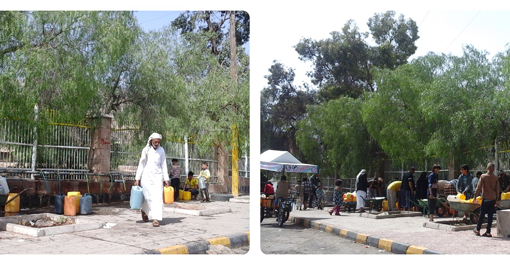By Musaed Aklan and Frank van Steenbergen
The continued unrest in Yemen is eating away at basic services. Now all basic public infrastructure is in a state of collapse: electricity, water and sanitation. The 33 Water and Sanitation Local Corporations in the country – the main service providers – have been badly affected. In most cases staff has been working for long periods without regular pay. The current stock of diesel of the Corporations is very thin – at only about 240,000 litres it amounts to only 8% of capacity.
Water production has been seriously hampered as less and less public wells are operational due to war damage, lack of maintenance and unavailability of fuel. In 2014, there were 80 wells in operation in the capital Sana’a. In 2015 this figure dropped to 55 wells. This has meant serious shortage of water and highly infrequent supplies.
In fact, the public water supply systems have stopped being important. Research by a PhD student at UNESCO-IHE and WEC (Water and Environment Centre- Sana’a) among 120 households selected across Sana’a city show that at present for 76% of families in cities, home delivery by private water tankers as the main source of water. Only 16% of households rely primarily on the public drinking water services. Before 2012 the majority of families depended on public water services with an expensive water tanker in most urban areas only ordered occasionally. Importantly, in Yemen’s cities there is also an increasing trend of collecting rainwater for private use and gardening. This is now practised by 20% of families – earlier it was only 5% who did so.
The demise in public water supply is mirrored in an even more dramatic collapse in energy services. The current fuel shortages have led to long electricity blackouts – affecting everybody with food storages, hospitals, traffic systems and schools among others having to cope with the sweltering heat. Before the war was unleashed on Yemen, 96% of families in cities relied on the city grids. There is now a see-saw change. Solar panels are everywhere. 70% of the households have solar energy as their primary source, whereas another 17% of people have generators as their main power supply. The public distribution is now only serving 12% of urban families.
 Whatever the charm of solar power systems, they have come at a cost that many cannot afford. The result is that in incessant temperatures for many there is just no cooling or light. Foods is spoilt, medicine stocks affected and in many schools boys are allowed to take off their shirts during lessons.
Whatever the charm of solar power systems, they have come at a cost that many cannot afford. The result is that in incessant temperatures for many there is just no cooling or light. Foods is spoilt, medicine stocks affected and in many schools boys are allowed to take off their shirts during lessons.



